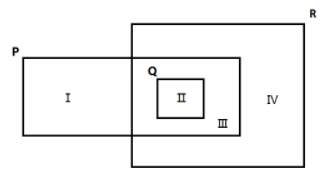Answer
394.5k+ views
Hint: Firstly, find the region of the inside bracket,\[\left( {Q \cup R} \right)\] which includes the region including both \[Q\] and \[R\]. Next, take the compliment of the region \[\left( {Q \cup R} \right)\] by excluding the region \[\left( {Q \cup R} \right)\] from the universal set or all regions. Lastly, solve \[\left[ {P \cap {{\left( {Q \cup R} \right)}^\prime }} \right]\] by taking the common region of set \[P\]and compliment of \[\left( {Q \cup R} \right)\] to find the required region.
Complete step by step solution: We can determine the region \[\left( {Q \cup R} \right)\] by finding the union of \[Q\] with\[R\], that is the region which includes both the sets \[Q\] and \[R\].
As, it is seen from the diagram, region Ⅱ, Ⅲ and Ⅳ includes the set \[Q\] and \[R\].
Next, take the compliment of the region \[\left( {Q \cup R} \right)\], that is, take the region excluding Ⅱ , Ⅲ and Ⅳ from the given diagram.
The region left after excluding the region Ⅱ, Ⅲ and Ⅳ is region Ⅰ.
We can see from the diagram, set \[P\]includes region Ⅰ, Ⅱ and Ⅲ.
Now, to solve the expression \[\left[ {P \cap {{\left( {Q \cup R} \right)}^\prime }} \right]\] take the intersection of set \[P\] and \[{\left( {Q \cup R} \right)^\prime }\], that is take the region with is common in set \[P\] and \[{\left( {Q \cup R} \right)^\prime }\].
The region Ⅰ is the common region of set \[P\] and \[{\left( {Q \cup R} \right)^\prime }\].
Hence, \[\left[ {P \cap {{\left( {Q \cup R} \right)}^\prime }} \right]\] represents region Ⅰ.
Note: Students often get confused with the symbols of union and intersection. \[ \cup \] represents union between two sets and \[ \cap \] represents intersection of the two sets. Identify the regions corresponding to the sets correctly. A single set may include more than one regions. Also, look at the given Venn diagram carefully before selecting the region.
Complete step by step solution: We can determine the region \[\left( {Q \cup R} \right)\] by finding the union of \[Q\] with\[R\], that is the region which includes both the sets \[Q\] and \[R\].
As, it is seen from the diagram, region Ⅱ, Ⅲ and Ⅳ includes the set \[Q\] and \[R\].
Next, take the compliment of the region \[\left( {Q \cup R} \right)\], that is, take the region excluding Ⅱ , Ⅲ and Ⅳ from the given diagram.
The region left after excluding the region Ⅱ, Ⅲ and Ⅳ is region Ⅰ.
We can see from the diagram, set \[P\]includes region Ⅰ, Ⅱ and Ⅲ.
Now, to solve the expression \[\left[ {P \cap {{\left( {Q \cup R} \right)}^\prime }} \right]\] take the intersection of set \[P\] and \[{\left( {Q \cup R} \right)^\prime }\], that is take the region with is common in set \[P\] and \[{\left( {Q \cup R} \right)^\prime }\].
The region Ⅰ is the common region of set \[P\] and \[{\left( {Q \cup R} \right)^\prime }\].
Hence, \[\left[ {P \cap {{\left( {Q \cup R} \right)}^\prime }} \right]\] represents region Ⅰ.
Note: Students often get confused with the symbols of union and intersection. \[ \cup \] represents union between two sets and \[ \cap \] represents intersection of the two sets. Identify the regions corresponding to the sets correctly. A single set may include more than one regions. Also, look at the given Venn diagram carefully before selecting the region.
Recently Updated Pages
Assertion The resistivity of a semiconductor increases class 13 physics CBSE

The Equation xxx + 2 is Satisfied when x is Equal to Class 10 Maths

How do you arrange NH4 + BF3 H2O C2H2 in increasing class 11 chemistry CBSE

Is H mCT and q mCT the same thing If so which is more class 11 chemistry CBSE

What are the possible quantum number for the last outermost class 11 chemistry CBSE

Is C2 paramagnetic or diamagnetic class 11 chemistry CBSE

Trending doubts
Difference between Prokaryotic cell and Eukaryotic class 11 biology CBSE

Difference Between Plant Cell and Animal Cell

Fill the blanks with the suitable prepositions 1 The class 9 english CBSE

Change the following sentences into negative and interrogative class 10 english CBSE

Give 10 examples for herbs , shrubs , climbers , creepers

What organs are located on the left side of your body class 11 biology CBSE

Write an application to the principal requesting five class 10 english CBSE

What is the type of food and mode of feeding of the class 11 biology CBSE

Name 10 Living and Non living things class 9 biology CBSE




